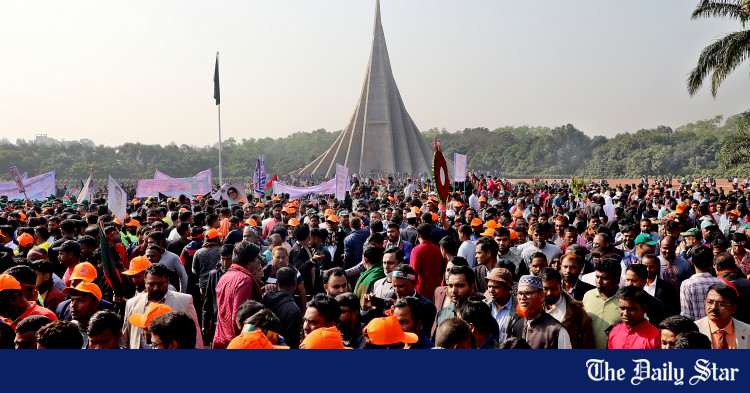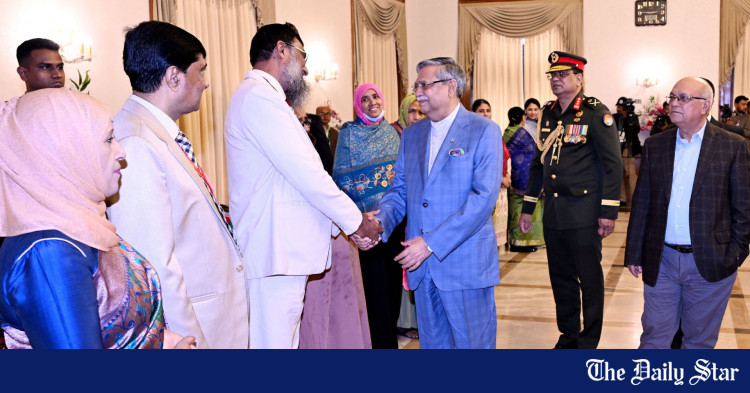Victory day today: The day a nation cried tears of joy
View attachment 11701
Joy in Dhaka street after Pakistan surrenders. Photo: Iranian Photographer Abbas Attar
From the first week of December 1971, freedom was already in the air. Pakistan was losing ground across Bangladesh to the joint forces, composed of the Mukti Bahini and the allied Indian forces. One by one, different regions were being liberated from the occupation forces.
By the second week of December, guerrilla fighters of the Mukti Bahini infiltrated various parts of Dhaka city. On Dhaka's outskirts, Manikganj and Narayanganj were freed from enemy occupation on December 13.
In a desperate effort to manage the deteriorating situation, the then governor of East Pakistan Dr MA Malik convened a cabinet meeting at the Governor's House in Dhaka at 12:00pm on December 14. However, by 9:30 that morning, the news of the meeting had already reached Major General JFR Jacob, chief of staff of the Indian eastern command, through signal intelligence. A plan to foil the meeting was soon underway.
In his book Surrender at Dacca: Birth of a Nation, Jacob himself wrote about this plan: "I immediately telephoned Air Vice Marshal Devasher the very competent Senior Air Staff Officer at Eastern Air Command in Shillong. We felt that a disruption of the meeting would spur the Governor to accept the surrender calls."
The Indian Air Force launched its first airstrike on the Governor's House at 11:15am.
Shortly after the strike, British journalist Gavin Young of The Observer visited the Governor's House to meet John Kelly, a representative of the United Nations High Commissioner for Refugees (UNHCR). In his book Worlds Apart, Young wrote that a panic-stricken Malik asked Kelly for advice on what to do at that critical moment. Kelly avoided the question as he was not willing to involve the UN in the matter.
When the airstrikes resumed, Dr Malik resigned from his position as governor and moved to the Intercontinental Hotel.
Amid this edgy situation in Dhaka, at 1:30pm, Pakistan's President Yahya Khan instructed Lt Gen AAK Niazi, the chief of staff of the eastern command, to take necessary steps to save lives. The message reached Dhaka at 3:00pm and by the evening, Niazi began the process of initiating a ceasefire.
A detailed account of how Niazi moved towards the ceasefire is documented in Siddiq Salik's book, Witness to Surrender. During the Liberation War, Salik served in Dhaka as the chief public relations officer under Tikka Khan and Niazi.
According to Salik's account, while drafting the ceasefire agreement, Niazi initially considered involving China and the Soviet Union as mediators. However, he eventually chose US Consul General Herbert Daniel Spivack in Dhaka as the intermediary.
Maj Gen Rao Farman Ali, the governor's adviser, accompanied Niazi to meet Spivack. Initially, Niazi held a private meeting with Spivack and requested Spivack to mediate a ceasefire agreement with India. However, Spivack declined to act as a mediator.
"I cannot negotiate a cease fire on your behalf. I can only send a message if you like," Spivack said.
At this point, Rao Farman Ali was summoned to draft the ceasefire message to be sent to Indian Army Chief General Sam Manekshaw.
Once the draft was finalised, Spivack remarked, "It will be transmitted in twenty minutes."
However, that night, Spivack did not send the draft to India; instead, he forwarded it to Washington.
In Witness to Surrender, Siddiq Salik wrote, "At that time, the US government tried to contact President Yahya Khan, but he was unreachable."
General Jacob in Surrender at Dacca noted that apparently Spivack had sent the message to their ambassador in Islamabad who in turn sent it to the State Department in Washington.
On December 15, just a day before the final victory, Pakistan sent a ceasefire proposal to Manekshaw. Both sides agreed to a ceasefire from 5:00pm on December 15 to 9:00am on December 16, which was later extended to 3:00pm.
Also on December 15, Poland proposed a 72-hour ceasefire at the United Nations Security Council, and called for the transfer of power to the elected representatives of East Pakistan.
Pakistan's representative at the UN, Zulfikar Ali Bhutto, reacted angrily.
In a report titled "Zulfikar Ali Bhutto Denouncing U.N. Security Council" published in The New York Times on December 16, Bhutto is quoted as saying: "I do not want to return with a surrender document…The Security Council has completely failed…They are only bringing up proposals for surrender in Dhaka. But why? Because their objective is the fall of Dhaka. But what will happen if Dhaka falls? What will happen if all of East Pakistan falls?"
Towards the end of his speech, Zulfikar Ali Bhutto tore up the ceasefire proposal document while declaring the intention to continue the war, and then walked out of the session.
On the same day, the presence of 20 Soviet naval ships in the Indian Ocean, supported by the Indian Navy, forced the US Seventh Fleet to change course. This destroyed the last hope of the Pakistanis. Earlier, on December 10, the US fleet had departed from Saigon towards the Indian Ocean, crossing the Malacca Strait on the night of December 13/14.
At 10:00am on December 15, India informed the Bangladesh government of Pakistan's imminent surrender. Colonel Das, an Indian liaison officer, conveyed the message to Faruq Aziz Khan, the personal secretary of the prime minister of Bangladesh.
In his book Basanta 1971, Faruq Aziz Khan writes that General Aurora spoke to Tajuddin Ahmad that night. Aurora stated that General Jacob would arrive in Dhaka at 10:00am the next day to implement the remaining decisions based on the ground situation.
The following morning, at 9:15am, General Manekshaw instructed General Jacob to ensure the surrender was completed by evening.
The entire nation awaited the final victory. By December 15, Gazipur was liberated from the occupation forces, leaving the Pakistani army effectively encircled in Dhaka.
According to General Jacob's book Surrender at Dacca, Major General Gandharv Singh Nagra reached the outskirts of Dhaka at 9:00am on December 16. From the end of Mirpur Bridge, General Nagra sent a message to the Pakistani outpost: "Dear Abdullah [Niazi], I am at Mirpur bridge. Send your representative."
At that time, Niazi was at the East Pakistan army headquarters in Dhaka cantonment. Upon receiving the message, he became utterly bewildered. He had been expecting General Jacob. Eventually, Pakistani Major General Jamshed welcomed General Nagra and escorted him to the cantonment.
Meanwhile, around 1:00pm, General Jacob and Colonel MS Khara, an intelligence officer, arrived at Tejgaon Airport by helicopter, carrying the surrender documents. They were received by Pakistani Brigadier Bakar Siddiqui and John Kelly, the UN representative in Dhaka. From there, Jacob proceeded to the East Pakistan army headquarters to discuss the surrender. He was greeted by General Niazi, Rao Farman Ali, and Major General Jamshed, commander of 36 Division of the Pakistan Army.
At one point, General Jacob and Colonel Khara entered Niazi's office to discuss the terms of surrender. General Nagra was already present there. The Pakistanis still believed they would be signing a ceasefire agreement rather than a surrender document.
Inside Niazi's office, discussions on the surrender began. The room fell silent as Colonel Khara read out the terms of surrender one by one. Tears rolled down Niazi's cheeks.
Eventually, Niazi agreed to surrender but expressed his desire to complete the process at his office. Jacob informed him that the Indian Army had planned for a public surrender ceremony at the Racecourse Maidan.
This finalised the arrangements for the formal surrender.
"Dhaka fell silently, like a heart patient succumbing to death," Siddiq Salik wrote describing the surrender negotiations in his book.
Later that afternoon, senior officials from the Allied Forces and the Mukti Bahini arrived in Dhaka from India by helicopter. Among them were General Aurora and Deputy Chief of Staff of the Mukti Bahini, A K Khandker.
Since Colonel Osmani was stationed in the liberated areas of Sylhet, A K Khandker was selected to represent the Mukti Bahini at the surrender ceremony in his absence.
In his book 1971: Bhitore Baire, AK Khandker writes, "On a late afternoon, we landed at Tejgaon Airport in a helicopter. As we descended, we saw thousands of people standing along the roads. We boarded a jeep and headed towards the Racecourse Ground. On our way, we witnessed people brimming with joy, their faces lit with smiles and an aura of relief."
From December 15, radio broadcasts about the impending surrender had already signalled Dhaka's residents that the event would take place post-noon. The city streets were charged with an electric atmosphere. By midday, the Racecourse Ground had transformed into a sea of people, with hundreds of thousands gathering in jubilant anticipation.
Amid the chants and slogans of the crowd, General Aurora and General Niazi, along with other generals, entered the Racecourse Ground.
In Witness to Surrender, Siddiq Salik describes the scene, "The vast ground bubbled with emotional Bengali crowds. They were all keen to witness the public humiliation of a West Pakistani General. The occasion was also to formalise the birth of Bangla desh."
Amid this fervour, the surrender ceremony commenced. First, a joint contingent of Pakistani and Indian forces presented a Guard of Honour to General Aurora. The surrender document was then placed on the table. General Niazi signed first, followed by General Aurora. As per the tradition of surrender, Niazi handed over his revolver to General Aurora.
Bangladesh burst into celebration. Some were speechless with joy, while others took to the streets in victory processions across the country.
Recalling the victorious moment, 77-year-old Abdal Hossain from the Rahmatganj area of Old Dhaka told The Daily Star, "We knew from the radio that the surrender would happen that day. By afternoon, the streets of Dhaka were packed with people. Some even started dancing in the streets. After hearing the news of the surrender, hundreds of people marched with flags. At that moment, everyone forgot who was friend and who was foe."
Overcome with emotion, he added, "That day was the only time in my life I saw my father cry."

















































